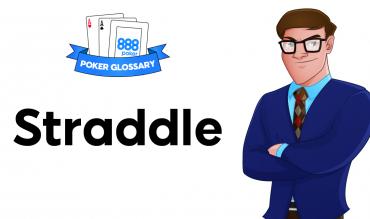Explanation of Straddle
In most cases the straddle is made by the UTG position (to the direct left of the BB). This is referred to as the “classic straddle” and is usually double the size of the BB (although not always). For example, in a $2/$5 game a UTG straddle would usually be $10. In exchange for this straddle UTG gets to act last preflop after the BB. Imagine a game of poker with 3 blinds instead of 2 – small blind, big blind and bigger blind.
Although the classic straddle is the most common type of straddle, it is not the only type of straddle; there are a large number of different variations. Whether they can be employed or not comes down to the specific house rules of the establishment that is offering the game.
Here are some other types of straddle -
Classic Double Straddle – This is a type of ‘re-straddle’ where a second player elects to straddle for an even larger amount after an initial straddle is made by another player. The classic double straddle occurs after a classic straddle is made by UTG. The player to the direct left of UTG makes an even larger straddle (usually double the size of the first straddle). We would hence be playing the equivalent of a poker game with 4 blinds. In a $2/$5 game we would hence expect $2/$5/$10/$20.
Mississippi Straddle - The Mississippi straddle is most commonly made by the button. (In fact, some sources say it can only be made on the button while others say the Mississippi straddle can be made in any position.) Similar to the classic straddle, the Mississippi straddle buys relative position, so the action starts to the left of the BTN. SB hence acts first not UTG. Once the action gets back around to the button he has the option to re-raise i.e. it’s a live straddle. (Sometimes players describe a straddle with the option to raise as a “live” straddle. If raising is not allowed, straddles are instead referred to as “sleeper straddles”).
Sleeper Straddle – The sleeper straddle can be made from any position. As its name might suggest, this is not a “live” straddle (although some casinos might treat it as such). If the action is called or folded around to the straddle, he does not have the option to raise. Unlike other types of straddle, the sleeper straddle does not buy relative position with his straddle. The action does not start to the left of the sleeper straddle but instead starts in the normal place (UTG).
Note that while the above formulate good rough guidelines, the exact implementations and rulings of straddles depend heavily on the house rules. It’s completely conceivable that a certain casino does not allows any form of straddling. If unsure, ask the dealer.
Example of Straddle used in a sentence -> The table agreed to a round of straddles.
How to Use Straddle as Part of Your Poker Strategy
Is straddling a profitable decision?
In short, no. One of the toughest areas to turn a profit in poker is the blinds (i.e. SB and BB). Being forced to make a mandatory investment into the pot is simply a huge disadvantage. Even very good players expect to make long term losses when playing poker out of the blinds. Voluntarily putting ourselves in this type of scenario is not generally a smart thing to do.
Are there any scenarios where straddling makes sense?
There are two main reasons why a good player might decide to straddle anyway.
1. Social reasons. The table has agreed to a round of straddles. Being the odd one out can make us unpopular really quickly. Besides, if everyone is straddling, it neutralizes any disadvantage.
2. Generating action. This reason is probably bogus, but since it’s impossible to quantify it should at the very least be mentioned. The idea is that straddling causes the table to loosen up and potentially result in more profitable postflop opportunities. Will this be enough to compensate for the hugely disadvantageous blind investment preflop? It seems rather unlikely, although “generating action” is typically the excuse players make when electing to straddle.
How does playing in a straddle pot affect our strategic outlook?
When the straddle is on, the value of the big-blind is effectively being redefined. So, in a $5/$10 game, the value of the BB is $10, and a $1000 stack constitutes 100 big-blinds. When a $20 straddle is on, the value of the BB is now effective $20 and a $1000 stack only constitutes 50bb. Any time a straddle is in place we are effective playing with shallower stacks than we would be otherwise. We hence need to loosen up our criteria regarding which types of hands are strong enough to stack off with postflop
See Also


